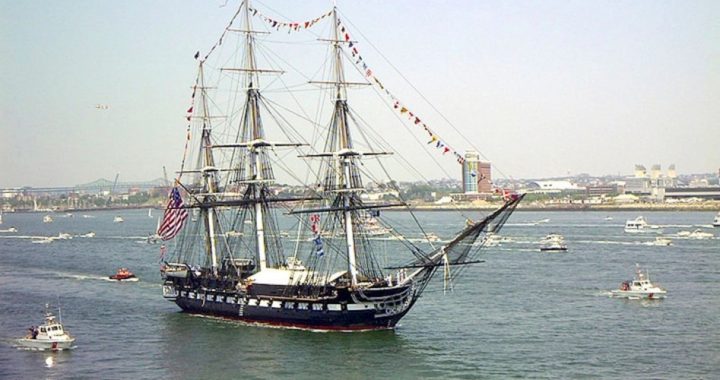
In 1830, Oliver Wendell Holmes, Sr. wrote a poem that 50 years ago millions of public school students read as both American literature and history. Its first few lines celebrate perhaps the most famous warship in the history of the American Navy:
Ay, tear her tattered ensign down!
Long has it waved on high,
And many an eye has danced to see
That banner in the sky;
Beneath it rung the battle shout,
And burst the cannon’s roar; —
The meteor of the ocean air
Shall sweep the clouds no more.
Holmes penned the tale of a warship formally named Constitution, a three-masted heavy frigate and one of the six original frigates commissioned by the fledgling navy in 1797 under the Naval Act of 1794. Congress took this action in response to the Barbary pirates’ attacks on American shipping and sailors. The official name of the warship was bestowed by George Washington, giving it a pedigree without compare.
Constitution was designed to be robust, able to outfight any ship that it could not outrun. The American Navy, which during the Revolutionary War often fought with small or old ships — sometimes provided by the French to audacious captains such as John Paul Jones — was not able to build and man a large fleet of ships. What was lacking in number, Congress intended, would be made up for in quality. The wood used in building the ship was hardy, as events would prove. The copper bolts and breastforks for the vessel were forged by none other than Paul Revere.
Constitution’s first sailings were relatively routine. She was involved in the First Barbary Pirates War and had several encounters with British naval vessels in the Mediterranean. But her real glory came in the War of 1812. In June of that year, the warship escaped five British naval vessels, even though becalmed, through the ingenuity of her captain.
Then, on August 19, 1812 — 200 years ago — Constitution fought the British frigate Guerriere. The British ship fired point blank at her, but because of the incredibly tough construction of the American ship, cannon fire bounced harmlessly off. An American sailor exclaimed: “Huzzah! Her sides are made of iron!” — the genesis of the nickname Old Ironsides. The news of the victory spread fast, and when Old Ironsides arrived back in Boston on August 30 the captain and crew were treated as heroes.
A few months later, on December 29, Old Ironsides engaged and defeated the British frigate Java, so alarming the British Admiralty that it sent out instructions to its ships not to engage the Constitution one-on-one. The fame of the American vessel grew by leaps and bounds. When the vessel returned to Boston on February 15, 1813, the captain and crew were greeted with even more fanfare than was the case after the defeat of Guerriere.
The legend of Old Ironsides was further enhanced by later battles. In 1815, for example, when she defeated the British ship Cyane, the British ship attempted to escape. The American ship swiftly overtook her and forced the British vessel to strike her colors and become a prize ship. Old Ironsides suffered very little damage in the battle, though the reason was not discovered until later: Cyane had hit the American ship with 12 32-pound cannonballs, but they had merely been embedded in the hull, not penetrating at all.
Most wooden sailing ships were expected to have a service life of just 10 to 15 years. In 1821 Old Ironsides, then 24 years old, was part of the U.S. Navy’s Mediterranean Squadron, returning to Boston in 1824. When the ship was 31 years old, the Boston Advertiser published an article relating that the Navy intended to scrap the Constitution. The Oliver Wendell Holmes poem appeared a few days later and raised such a public ruckus that the Navy promptly discarded any such idea.
Incredibly, Old Ironsides was not only repaired and refitted, but was dispatched to Europe in 1836 as the flagship of the American Mediterranean Squadron, serving there for two years until returning to America. In 1843 the ship began a trip around the world, and in the next 10 years returned to the Mediterranean and then to the African Squadron, capturing as a prize ship the American schooner H. N. Gambrill, which was involved in the now-banned slave trade.
Old Ironsides has formally remained in active service ever since then, although since the Civil War it had been used primarily as a training vessel. The storied ship has sailed through the Panama Canal, met and fired salutes for kings and queens, greeted popes, and carried the remarkable legacy of its early life in the brand-new American Republic all around the globe.
Since the bicentennial year, 1976, the U.S.S. Constitution Museum, located right by Old Ironsides, has collected all things related to the famous ship and offered a variety of programs and exhibits with the following stated mission: “We seek to create a positive, memorable experience for both children and adults by inspiring within them a love for the freedom that Constitution symbolizes.”
The museum president’s welcome this year carried the same theme: “July 4, 2012 as international tall ships gather in Boston Harbor and the Blue Angels fly overhead, across the nation, people will pause to reflect on the courage and commitment of sailors who fought to defend American freedom — a freedom we continue to enjoy today. There is no better living symbol of this remarkable moment in time than USS Constitution.”
The defense of freedom, the love of freedom, that is the true story of Old Ironsides — the ship no cannonball could sink.
Photo of Old Ironsides on July 4, 2002 making her annual July 4th “turnaround cruise” in Boston Harbor: U.S. Navy



